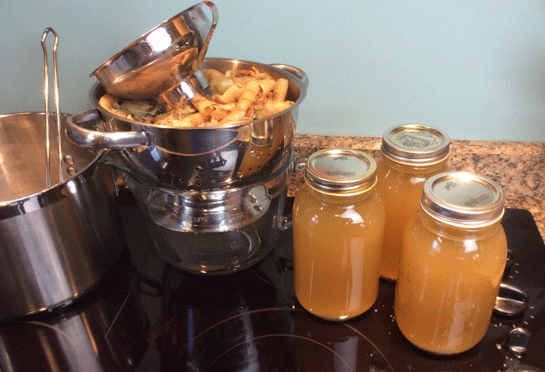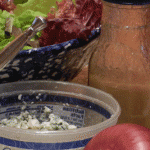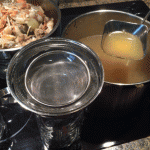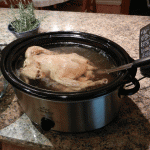
There are certain basic foods and food preparation techniques that reappear again and again in support of a healthy diet. Bone broth is an obvious example, but there are other techniques as well that can save you a lot of time and effort. Read about the health benefits of bone broth here.
 Everyday Lemon and Olive Oil Dressing and Marinade - This dressing is like a Caesar salad, but without eggs. It is so clean tasting we use it as our everyday “house” dressing. It’s tastier than any commercial dressing you can buy.
Everyday Lemon and Olive Oil Dressing and Marinade - This dressing is like a Caesar salad, but without eggs. It is so clean tasting we use it as our everyday “house” dressing. It’s tastier than any commercial dressing you can buy. Fish or Seafood Broth - Fish broth and fish soup is the easiest of all soups. Fish heads provide many nutrients including many minerals, especially iodine, which is necessary for healthy thyroid function.
Fish or Seafood Broth - Fish broth and fish soup is the easiest of all soups. Fish heads provide many nutrients including many minerals, especially iodine, which is necessary for healthy thyroid function.
 Chicken or Poultry Bone Broth - Having great chicken broth on hand makes excellent soups and gravies easy. This method is designed to maximize the flavor and nutritional value of the broth. Using vinegar helps to draw minerals from the bones. The long simmer releases cartilage and minerals into the flavorful liquid.
Chicken or Poultry Bone Broth - Having great chicken broth on hand makes excellent soups and gravies easy. This method is designed to maximize the flavor and nutritional value of the broth. Using vinegar helps to draw minerals from the bones. The long simmer releases cartilage and minerals into the flavorful liquid.
I have sibo and the glucosamine in the cartilage provokes feeding of the bacteria. So beef bone broth is the same for oxylates reduction?
I am not sure that I understand your question. If you have had a diagnostic work up to confirm the diagnosis of SIBO, a key target of therapy is to correct the tone (function) of the muscles and nerves that control the connection between the small and large intestine. Oxalate toxicity can disable the nerves of the digestive tract and also trigger inflammation that contributes to a cycle of dysfunction. Bloating and gas can accompany oxalate toxicity. Lowering your oxalate intake (and vitamin C) could potentially help you resolve the SIBO by restoring the function of the intestinal nerves and muscles. This may not be an instant fix, however. In the meantime, a low carbohydrate diet might help to “starve” some of the problematic overgrowth. Please see a qualified health care provider about additional treatment options.
Hi Sally, I’m new to your work and absolutely loving it! It explains a lot of things I’ve suspected in the past (at a feeling level) and highlights some things I didn’t realize before. I’m already inadvertently mostly oxalate free in my diet (mostly carnivore, and slowly working towards all raw). One of the things I didn’t realize is the vitamin C issue. I’ve been taking 1,000 mg. liposomal vitamin C (from Mercola) most days for about 6 months now. I’m going to guess now that that’s way too much. Would you agree? If so, what would be a good amount to possibly supplement, if any at all? Thanks.
Hi Candace! FYI I wrote about Vitamin C in this blog post: https://sallyknorton.com/taking-vitamin-c-try-a-salad-instead/. The RDA for Vitamin C (currently 75mg per day) might be appropriate for the standard carb-heavy diet. People doing a carnivore diet for many years never seem to develop any C deficiency signs, so they claim that Vitamin C needs are extremely small especially in the context of a low-carb/carnivore diet. On the other hand, there are a lot of claims and theories that promote the use of supplemental Vitamin C. The metabolism of Vitamin C to oxalate is a known problem that may occur more strongly in some individuals than others. We don’t have any way to identify who is likely to turn their Vitamin C into oxalate, or whether it becomes too much. If you consider all those perspectives, caution with Vitamin C supplements makes sense. My current rule of thumb is this: if you keep your supplemental Vitamin C at 250 mg or less, it probably won’t cause problems for the average person. On the other hand, the expense and daily chore of taking that supplement may be completely unnecessary and offer few health benefits, so you could consider skipping it altogether. A food-based alternative would be to juice a fresh lemon every day, which would provide citrate and Vitamin C. The citrate helps to prevent oxalate accumulation in the kidneys.
In reference to bone broths, I have read that gelatine consumption can lead to oxalate formation in the body, is this a concern if you are regularly consuming bone broth or using a collagen supplement?
thanks
Tony
Hi Tony! Thanks for reading the website. You’ll be glad to know that I addressed this exact question on the Health Benefits of Broth page, which I fear may be a bit hard to find (it’s linked at the bottom of the “Nourishment” page, under “Relief” in the Main Menu). Scroll down to the section “Can Broth Add to a Vicious Cycle” which reviews the science (the page was written in 2015, but it’s still current). If you have an active oxalate problem (e.g. stone formation, or diet-responsive symptoms that suggest you may be working out an accumulation problem) you may want to limit your broth consumption (a little goes a long way in helping food be delicious) and be sparing in your use of collagen supplements. Because rebuilding connective tissue is very important as one recovers from oxalate accumulation, the nutrients that are readily available in broth are likely to support connective tissue recovery when used in moderation (though remember that the key way to “moderate” is to lower your intake of oxalates from other sources). Other supplements to support joint health may also be beneficial (namely, BioSil). Finally, Calcium-Magnesium Citrate can bind ingested oxalates in your colon and (along with potassium citrate and lemon juice) help your kidneys eliminate those already in your body (in effect, improving your body’s ability to eliminate oxalate).
Ahhh, and this reminds me of another important question:
I’ve had some potassium citrate (as well as magnesium bisglycinate) around for at least 8 months now, but it’s capsules with some nice magnesium stearate in them. Not good. What source/brand of Potassium Citrate and Calcium-Magnesium Citrate do you think is best?
Thank you!
is beef bone broth good? we have been making it for our dogs. For a person how do you eat bone broth it doesnt look or smell very appetizing to me so wondering what amount of bone broth should one be eating in a day and how would you eat it. We just add it on top of our dogs food and mix it in.
Hi Laura. Bone broth is great for connective tissue, though I recommend limiting it to 1/2 to 1 Cup a day as there is some research to suggest compounds in it can increase internal production of oxalate a bit. Use it as a base for soup, or just drink it. As a drink: heat it up, add some coconut milk power (e.g. Native Forest) or coconut milk (not worth opening an entire can just for the drink), add some salt and white pepper, and perhaps some sour flavoring (a few drops of vinegar or lime juice). Drink like tea between, before or with meals. Enjoy.
Best,
Sally
I have histamine problems – is there a way around this or do I need to keep avoiding aged, fermented foods and broths?
Hi Ally,
For people with oxalate problems, the histamine problem is sometimes a protracted (though still temporary) phase as the oxalates cause an over-stimulated immune response and trigger mast cells, while impairing generation of the enzyme that clears histamine. Excessive oxalates, an overactive immune system, and leaky gut often combine to create excessive sensitivities and reactivity to foods (including the molds that come along with fermented foods). You need a lot of time for the immune system to work on clearing out the oxalate problem, and your immune system may stay on “high alert” for many years. For some of us, just avoiding fermented foods is the easiest way to stay out of trouble. But others have found that systematically reducing oxalates resolves their histamine problem quite quickly.
Sally
Hey
I am super healthy…but..had a parathyroidechtimy 3 yrs ago, so always careful of too much calcium:phosphate
I have wicked arthritis as well
How can i tell if i am oxalate sensitive?
Amy in CA
The easiest way to check for oxalate toxicity is to use my Oxalate Symptom and Exposure Inventory. If the inventory suggests you have been over-eating oxalates recently or in the past, then you can try lowering your oxalate intake by phasing out the “worst offenders” and see what your body tells you. Sometimes some weird stuff will start happening as you lower your intake and you start letting go of oxalate accumulations, which can also be a sign that your system is ready to start cleaning it up. Gradually transitioning to lower oxalate eating is usually the best strategy.
My family loves scones. What flour can I use? Is sour dough bread better than rye?
Tests of white wheat and rye flours suggest they have about 30 mg or more of oxalate per 100g (a little less than 4 ounces). A standard half cup of flour weighs about 65 grams and might have around 20mg of oxalate or more. That makes both wheat and rye rather high. Whole wheat flour has more than twice the oxalate as white (the bran has a high oxalate content). Sourdough can be beneficial because the fermentation makes it more digestible and can reduce other toxins (though probably not oxalate, alas).
Whether scones are a problem will depend on how big they are, and how many you’re eating. Plus of course whatever else is in your diet!
The only flours that are low are white rice and coconut, but doubt you could make scones with them. Maybe you can bake other things.
There are a lot of recipes using coconut flour. Pinterest would be a great place to start.
Is it possible to boild oxylates out of beets and broccoli? Thank you for your work and be well!
Boiling beets won’t help: you would have to chop them small, boil them to mush, discard the water, and you would have more than half the original oxalate left, which is still a huge amount.
On the other hand, Sally does strongly recommend boiling broccoli. Broccoli starts out with much lower in oxalate content, and boiling (plus discarding the water) can remove about a third of that, making it a useful food.
I can’t imagine eating ANY of the foods in Sally’s recipes! I had 4-5 weeks of excruciating pain through my body when I cold turkeyed all carbs and never want to go through that again. I got really tired of expensive steaks and now mostly eat ground beef (not grass fed bc I didn’t like it and it’s expensive for a 77 year old woman on social security) and chuck that I shred after cooking in my crock pot. I eat eggs, too, and added vermont white extra sharp cheese and high fat whipping cream back in my diet. A month ago, I started adding sauteed onions to my ground beef. That’s it. I’m 77 so will not be doing any of Sally’s recipes…not my thing.
If you suffer from high oxalates in the body because of not enough citrate in urine and the oxalate issue caused histamine intolerable, can you add in lemon juice, even though it’s high in histamine, will it help lower the oxalate level and address flushing out oxalate to lower histamine. I can’t use sodium bicarbonate because of a blood disorder because it would cause inflammation. Thank you!
Hi, I am needing to start a lower Oxalate AND fodmap diet. I’m finding it impossible to find any resources that include both and when I look individually, the 2 seem to counter eachother so I’m feeling very limited. Do you have any advice of where I can find some recipes or ideas on how to achieve both of these diets simultaneously?
Thanks
How does this oxalate diet work with the low-carb diet idea/ketone diet. I hear so much conflicting information on which diets are best!!! Also, where does flax fit into your diet?
Bonjour, vous dites que les bouillons d’os et de poulet sont bon pour la santé ,j’ai fait une crie de goute et on m’a interdit les bouillons d’os et de viande qui sont très acides qui provoquent des cristaux dans les articulation , un peut comme les oxalates !Alors je ne comprend pas comment cela pourrais être bon pour la santé ! pouvez vous me donnez une explication ? merci par avance.